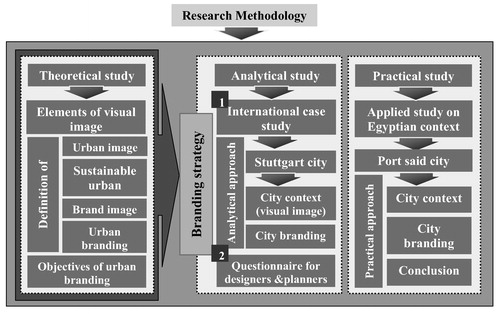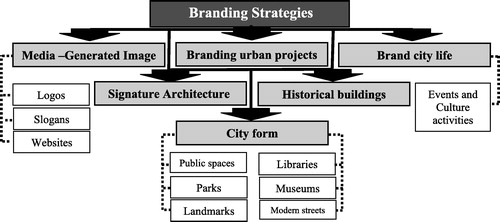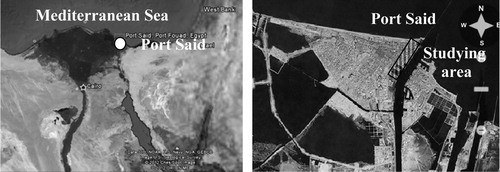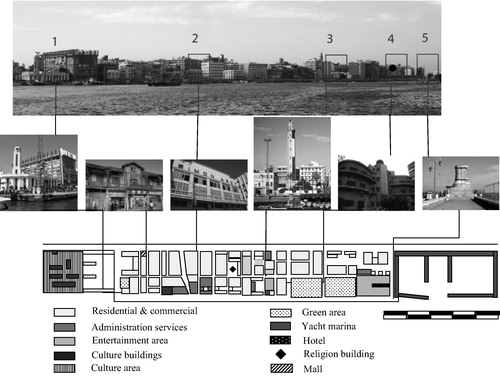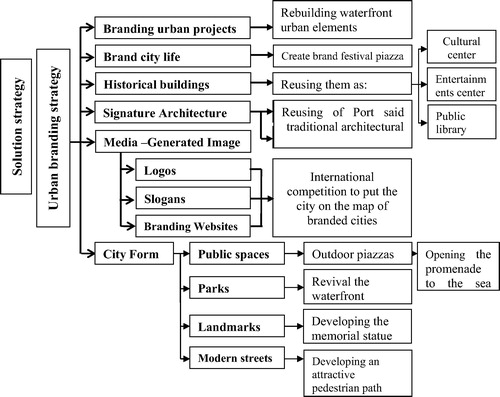Abstract
Sustainability in the urban image is one of the most important strategies for sustainable urban design. Most of cities are trying to strengthen its visual image to achieve a sustainable urban image by integrating non physical elements such as culture, economic, social aspects and activities through some of new strategies. One of these strategies is urban branding strategy.
Urban branding is a new approach toward urban development of sustainable cities. City branding, a novel aspect of urban communication, improves marketing of the city image in various ways by converting the visual image of the city into a brand image. Unique characteristics of the city are featured and a sustainable urban image is created. This paper will focus on city branding as a powerful image-building strategy. In this realm, the branding of Stuttgart, Germany, serves as a successful model of a branding strategy. Next, branding of the city of Port Said, Egypt, will be explored. The principal aim of this paper is to describe how cities become branded; how branding succeeds; and how a viable city image is created. This paper reviews the methods used to brand cities, and concludes by emphasizing the importance of urban branding in terms of sustainability.
Introduction
A good city image is a meaningful synthesis of activity and structure. Image planning strategies have become essential for cities that seek to thrive in the global economy. Such branding often stresses unique aspects of city culture and creativity; attractive urban images are promoted.
In the West, experience dictates that city marketing in terms of urban development, tourist destinations, cultural festivals, entertainment events, and promotion of investment, can play important roles in strategic planning of economic, urban, touristic, and cultural development. The vision of branding is to promote a city as an excellent venue in which to seek success.
The research problem
Traditional visual images no longer suffice to project a sustainable urban image. Non-physical factors affecting any urban image play very important roles, and must be linked to visual imagery to present a coherent city image.
In this paper, there are four principal questions:
| (1) | What is the utility of an urban image? Is a good urban image the goal? | ||||
| (2) | Why is it necessary to create a brand image for a city or to re-brand a city? | ||||
| (3) | How can a city brand image be created? | ||||
| (4) | Have cities succeeded in achieving a balance between existing development, developmental plans, major projects, and urban branding. Does a “successful city image” exist? | ||||
Research methodology
The paper explores the concept of urban branding from theoretical, analytical, and practical viewpoints; the desired endpoint is sustainability. It seeks to identify the basic features of a viable urban branding strategy. Next, it analyzes how the concept of “Stuttgart city” was developed; it explores the theoretical approach toward city branding in that context. Finally, in practical terms, it administered a questionnaire to planners and designers to identify the stages by which an Egyptian city (Port Said city); might be effectively branded ().
Research objectives
The principal objective of this paper is to emphasize the role plays by urban branding in city design and sustainability. The secondary goals are:
| – | To strengthen the economic value of the image of a city; | ||||
| – | To improve the visual image of a city by reference to cultural and economic activities; | ||||
| – | To develop creative ways by which the city image might be disseminated worldwide; to embrace the role of media in this process; | ||||
| – | To discuss how sustainable urban character might be achieved; | ||||
| – | To propose how to develop the visual impact of urban development projects; | ||||
| – | To create the suitable image facilitates sustainable development. | ||||
Research hypothesis
Urban branding strategies can positively impact the ability of a city to achieve desired economic, social, and cultural objectives. Such branding can develop the visual image of a city by integrating historical and cultural icons with modern urban elements and new landmark buildings.
Urban branding as an approach to sustainable urban development
A sustainable urban image
To understand the concept of a sustainable urban image, it is first necessary to define visual image, urban image and sustainability. First “visual image is legible, real and tangible” [Citation1], “it contains many elements, defined by Lynch as paths, edges, districts, nodes, and landmarks” [Citation2]. Then an urban image is an attribute (or set of attributes) combined with special characteristics that define the scope of a particular urban setting. These include format interfaces, colors, the skyline and cultural content. Cultural and economic use of a venue can greatly affect physical character. It is important to ask (and answer): “What is the advantage of a good urban image, and should such an image be sought?”. On the other hand, sustainability embraces social, economic, and cultural aspects of a developmental process. In addition, “sustainability implies the protection of non-renewable resources at an acceptable cost to benefit the society and the state” [Citation3].
“Sustainability requires a comprehensive vision; it requires multi-dimensional indicators to show the relationship between economic, social and cultural aspects” [Citation4]. “Sustainable development implies development to meet the needs of current generations without negative impact on meeting the needs of future generations” [Citation5]. To create a sustainable urban image it is necessary to link the physical character of the built environment with the environmental, social, economic, and cultural aspects of that environment. Urban branding integrates socio-cultural, economic, and environmental themes into the city. The cities of today evolve constantly and compete intensely to project an attractive image. Cities first seek to strengthen the visual image, and, next, to link that content to cultural and economic activity.
Thus, this paper focuses on the concept of urban branding, and defines the most important objectives of such branding. It also explains how a city can create a brand image.
Definition of brand image
“Brand image is the current view of the customers about a brand. It signifies what the brand presently stands for. In addition, it is the overall impression in consumers’ mind that formed from all sources” [Citation6]. “Places get to be real brand only when the visitors say these are distinctive as” [Citation7]; “a brand is originally a mark of identity” [Citation8].
Definition of urban branding
“As concerning urban branding of built environment introduces a new language in the community of professionals that works on urban design and the restructuring of neighborhoods” [Citation9]. The concept of urban branding is novel, and may be defined as the process by which unique physical features of the city are defined, and come to encapsulate the essence of the place. “Moreover, urban branding is not only limited to the promotion of a positive image of the city, but it extends more, to change it into an urban experience” [Citation3]. “It is a process of differentiation and diversification whereby local tourism organizations, arts and cultural facilities, museums, historic preservation groups harness and construct place images, help producing tourist sites to attract consumers and investment to a particular local area” [Citation10]. “Branding of places and cities consists of two main elements, such as follows:
| (1) | Place making or city building, a process that makes the place specifically advantageous or attractive. | ||||
| (2) | Place or city marketing, an effort to promote the place/city specific advantage” [Citation3]. | ||||
The objectives of urban branding
“The main goals of urban branding are to reimaging a city, to depend on place-based identities and understanding of a particular local culture” [Citation6]. “Yet urban branding is more than a strategic and rationalized form of place promotion and marketing; It is about constructing and shaping an “urban imaginary”, which is understood to be a “historically based ensemble of representations drawn from architecture and street plans of the city, the art produced by its residents, and the images of the city, heard, or read in the movies, on television, in magazines, and other forms of mass media” [Citation7]. Urban branding aims to create a clear, unique, and consumer-oriented version of the urban image that can “attract desirable consumers and maximizing consumer spending” [Citation10]. “Urban branding therefore is geared to adapting, reshaping, and manipulating images of the place to be desirable to the targeted consumer” [Citation8].
Therefore, Urban Branding aims mainly to:
| (1) | “Develop new ways of communicating city image to the rest of the region, or to the world as a whole, which is considered as media generated image” [Citation3]. | ||||
| (2) | Achieve competitive advantages regionally and internationally. | ||||
| (3) | “Strengthen the reputation of the city and its corporate identity that improves its economical importance” [Citation3]. | ||||
Urban branding strategies
“The making of a good city image is a meaningful synthesis of activity and structure. The use of image planning strategies has become an essential need for cities in order to survive in the global economy. Since successful brands give benefit beyond the physical aspects of cities, there is a big desire to transfer the visual image into a unique brand image through certain strategies. There are different urban branding strategies that could be developed based on diverse city development objectives and visions, such as large scale urban projects, signed architecture, events, media, etc” [Citation3]. “Urban branding strategies are not limited to the promotion of the city image, but it extends more, to change it into an urban experience for the interest of investors, politicians, real estate and construction projects, planners, architects, and other groups that stand to profit from enhancing the role of their cities” [Citation3].
“City branding means the main things that should people know about certain place” [Citation8]. The process of brand creation requires media-generated imagery; branding of urban projects; and branding of city life, historical buildings, signature architecture, and the overall form of the city ().
Analytical study (Stuttgart, Germany)
In this part, the paper discusses Stuttgart city, Germany, as an example of how urban branding may be achieved. “Stuttgart is the capital of the state of Baden-Württemberg in southern Germany, and it is the sixth-largest city in Germany. It is not only an industrial city with global famous automobile companies, state-of-the-art science and research facilities, but also a cultural city that has made a name for itself through its renowned State Opera, and the exceptional art collections at the State Gallery. Stuttgart’s main attractions are clearly the hilly landscape, the several parks that make Stuttgart one of the greenest cities in Germany and the mineral water fountains that characterize this region as having the largest source of mineral water in Western Europe” [Citation11].
Branding strategies in Stuttgart
The branding vision for Stuttgart is to promote the city as an excellent place to live and visit; the city is the essence of success. Many branding sub-strategies have been developed; these embrace all aspects of sustainable development. Many major features of the city have been branded; these include urban projects, city life per se, events and cultural activities, and signature architectural features.
Branding of urban projects
New urban projects are frequently undertaken in Stuttgart. The branding of urban projects has benefited from branding of the city, and vice versa. The effectiveness of new projects is emphasized with the aid of superlative descriptors; a project may be the “biggest” in the region. Such hyperbola often accompanies urban project description. The aim is to redevelop the city. An example of such work is the new railway station, to be completed in 2021. The “Stuttgart 21” project is one of the largest urban renewal projects in Germany, and indeed Europe.
The principal idea is to change the traditional face of Stuttgart, to match the rapid development of the city. The transforming projects are branded as continuous cultural events, even though some citizens oppose these efforts [Citation1].
Branding of city life
The branding of Stuttgart city life features various events and cultural activities. These are transformative tools rendering the urban image always new and active.
Many international events and regional festivals take place in Stuttgart. These include Christmas festivities, an Easter festival in February, and a Stuttgart Spring festival in May. The city is widely seen to be a very attractive place in which to hold events and celebrations.
Historical buildings
The promotion of Stuttgart as a cultural city is an additional feature of current developmental activities. The city has many historic buildings, including an Opera House, the Residence Castle, and the New Palace. These and other buildings, are branded, and attract tourists.
Signature architecture
Stuttgart has attracted the attention of many prominent international architects who design and construct landmark buildings. Ben van Berkel designed the “Mercedes-Benz Museum” and Delugan Meissl Associated Architects of Vienna designed the “Porsche-Museum” and “Planetarium Stuttgart”. In Stuttgart, “architecture has a significant role in branding the city through creation of new icons, unprecedented landmarks to discover new unique and distinct architectural images that can be better promoted” [Citation3]. Also, the linking of such “Signature Architecture Icons” with historical aspects of city development, particularly car production, allow the icons to have a deep impact, sustaining the brand image of the city.
Media-generated imagery
The urban image of Stuttgart is featured in postcards, advertising campaigns, TV reports, movies, documentaries, city publications, and websites.
Logos: “A logo is a graphic mark used to identify a city. Stuttgart logo is a black horse standing on its hind legs on a yellow background, it suggests speed and power, and shows that the city enters the future with a strong economic base. In July 2010, Stuttgart is unveiled a new city logo, designed to attract more business people” [Citation12].
Slogans: A slogan is a short phrase that is easy to remember and used to extract a characteristic attitude or a goal to be achieved. It is an attractive phrase associated a brand, and it becomes an important component of the city identification or image. Stuttgart slogans vary with vision; an example is a “sporty” slogan. “The city’s tourism slogan is “Stuttgart is more”. In March 2008 the city unveiled a new slogan, describing itself as “The new heart of Europe”. For business it describes itself as “Where business meets the future”. In 2007 the head of government marketed Stuttgart to foreign investors as “The creative power of Germany” [Citation12].
Websites branding Stuttgart: The websites of Stuttgart are of high quality and send the message that the city is developing rapidly and becoming transformed into a global city. Many websites brand Stuttgart in general; these include: http://www.justgermany.org/germany/stuttgart/stuttgart-maps.asp (Stuttgart maps); http://www.justgermany.org/germany/stuttgart/photos/ (Stuttgart photographs); and http://www.justgermany.org/germany/stuttgart/stuttgart-maps.asp (Stuttgart museums).
City form
Branding of city form is an important part of urban branding. Form includes public spaces, parks, landmarks, libraries, museums, and modern streets.
Public spaces: “Public spaces like (Palace Square). It is one of the main attractions of Stuttgart and surrounded by many buildings dating from royal times. The Column is in the center of the garden, it was given to King William I in 1841” [Citation11].
Parks: “Many different parks throughout Stuttgart help making the city one of the greenest areas in Europe; the greenest part in Stuttgart is a U-shaped area” [Citation11]. Thus, extensive parks and gardens are an important part of the city’s history.
Landmarks: “Landmarks in Stuttgart city are numerous and they have many types, type of construction, functions, etc. For example, the “Stiftskirche”, which was founded in the 12th century” [Citation11]. Another example is the TV tower, an icon of construction.
Modern streets: “King Street is the biggest commercial street in Stuttgart city. It is designed for pedestrians. Old and new palaces are in the center of it” [Citation13]. This is a successful example of how a climate that welcomes social activities is created; the central square is the location of the principal celebrations held on New Year’s Eve.
Practical study
Practical study depends on two terms; a questionnaire and a case study of Port Said city.
Questionnaire for professionals in urban design
After considering city branding to achieve a sustainable urban image, this paper suggests that an urban branding strategy can be developed by taking the opinions of the designers and planners on urban branding strategy. This is through a questionnaire for an examination sample covers practical professionals in urban development, and academic experts in urban planning and design from 3 Egyptian universities.
The principal aim of the questionnaire was to explore the suitability of any urban branding strategy that is to be applied to a particular city and to review the methods used to brand cities. This is done through the set of questions about urban branding strategy which addressed to the above noted urban designers and planners experts.
The main lines of the questionnaire depend on the basic requirements of urban branding strategy, and it was divided into six major areas, which includes branding of urban projects, branding of city life, events and cultural activities, historical buildings, signature architectural and media-generated imagery.
Discussion
The results of the questionnaire show that most respondents are of the view that many elements must be considered to sustain city branding via visual imagery. “Media-generated imagery”, “branding of urban projects”, “historical buildings”, and “signature architecture” were the principal elements selected as important. About 35% of respondents agreed that “media-generated imagery” influenced the visual image of the city; 20% agreed that branding of urban projects was important in this context; 15% agreed that historical buildings play important roles; and 15% emphasized the importance of signature architecture. Also, 5% of respondents focused on the importance of city form. In addition, 10% of respondents were of the view that all of the above influenced the visual image of the city ().
Fig. 3 The result of asking about the role of city branding elements in sustaining urban character. Ref.: The researcher.
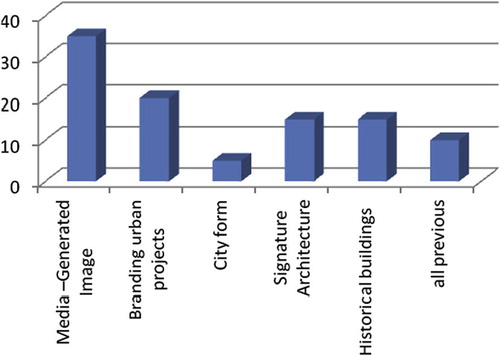
In terms of “the process of urban branding”, about 55% of respondents considered that economic and social activities affected urban character (), and about 60% agreed that signature architecture and historical buildings played important roles (). Also, about 80% expressed the view that branding of urban projects can affect the brand image of any city (). Also, most agreed that festivals, preservation of historic buildings, and city marketing, were the main elements helpful in creation of a brand image for any city.
Fig. 4 The opinion of the sample about, if there is an impact of economic and social activities on the urban character. Ref.: The researcher.
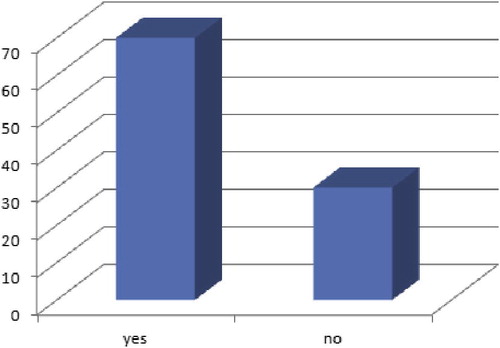
Fig. 5 The opinion of the sample about, if there is an impact of the signature architecture and historical buildings on the urban character. Ref.: The researcher.
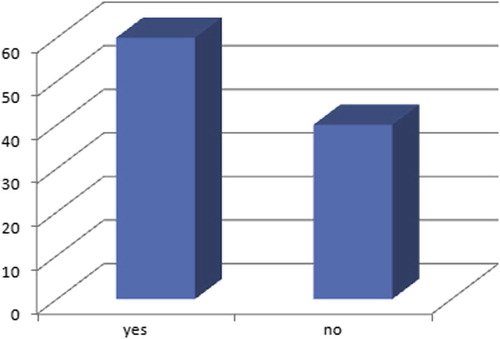
Fig. 6 The opinion of the sample about, if there is an impact of the branding urban projects on the urban character. Ref.: The researcher.
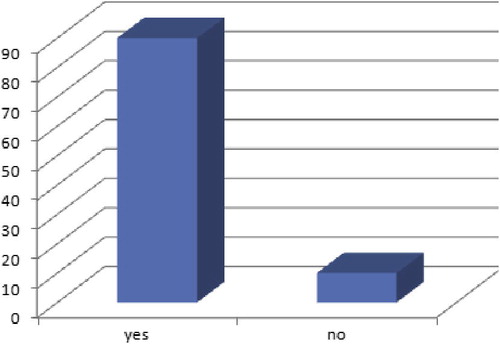
Thus, planners and designers are aware of the importance of “urban branding” and the impact thereof on achievement of a successful city image. It is agreed that many elements, including “media-generated imagery”, “branding of urban projects”, “historical buildings”, and “signature architecture”, should be used to sustain effective branding.
Case study (Port Said, Egypt)
In this part, Port Said, Egypt, is studied. The aim is to identify a strategy that would allow Port Said to be transformed into a city with a successful brand; the potential is certainly present. The argument will focus principally on the promenade along the Suez Canal; this is the sea gate and a major feature of the city.
The reasons of choosing Port Said are;
| – | “Port Said was a truly international city and the gateway between two continents, Europe and Africa”. And it lies at the crossroads of the world” [Citation14]. | ||||
| – | “It was soon the largest coaling station for steam ships in the world” [Citation15]. | ||||
| – | Port Said is located at the northern entrance of the Suez Canal. | ||||
| – | In the past, the brand image of the city was very strong, but has now been largely lost. There is a need to re-activate the brand. | ||||
City context
Location: “Port Said is a city that lies in north east Egypt extending about 30 km along the coast of Mediterranean Sea, at the north of Suez Canal” [Citation14] ( and ).
The visual image of Port Said
| – | Landmarks: Port Said has many landmarks, imparting a distinctive look: | ||||
| – | “The lighthouse is one of the most important architectural landmarks in the city. It is considered a unique example for the evolution of architecture during the nineteenth century, and it is the first building in the world built from reinforced concrete” [Citation16]. Currently, the surrounding environment negatively affects visual aspects of the lighthouse. | ||||
| – | “One of the most striking sights to greet the visitor to Port Said is the historic office building of Suez Canal Company with its three green domes on the waterfront at the entrance to the canal. The building was constructed in 1895” [Citation16] (A). The building is currently neglected but has the potential to be a major tourist destination. | ||||
| – | “Simon Arzt Store, was built in 1923, its prime position on Port Said waterfront, it was one of the great department stores worldwide. This building is a typical example of the European styles that were common in the larger cities of the Mediterranean at this time and is one of the most impressive structures in Port Said” [Citation16] (B). Again, the building is currently in poor condition (C). | ||||
| – | The National Museum had a variety of displays covering all eras of Egyptian history. This museum has been demolished but no new construction has commenced. | ||||
| – | Port Said Military Museum: This museum was established in 1964. It relates the story of Egyptian resistance in Port Said during the Suez Crisis of 1956 and the wars of 1967 and 1973. It also contains a hall explaining the genesis of the city and the Suez Canal. | ||||
| – | Main streets: The promenade is one of the main streets of Port Said and, historically, had a distinctive urban nature. However, the current streetscape lacks such an identity. Also, the street is not in harmony with the architectural heritage of the city. | ||||
| – | District: “The urban planning regulations of Port Said ensure that the city retains a remarkable homogeneity despite the existence of various types of structure. The use of wood on all facades, built to the standard of the Afrang neighborhood, and the presence of arcades along main streets, happily convey a sense of unity. In the early twentieth century, architects borrowed Islamic or Arabic elements including window borders, balconies enclosed with wood, and Arabic decorative motifs” [Citation17]. Now, however, the city lacks identity and a sense of culture. | ||||
| – | Edges: The promenade lacks the feel of a waterfront. Character and culture are compromised by the presence of high-rise buildings and elevation of the promenade (). | ||||
City branding
This is discussed below.
Branding of urban projects
Branding of urban projects benefits city branding and vice versa. Port Said has not sought to brand urban projects, and the historical identity of the city is a key to rebranding. Reformulation of the built environment in line with the architectural heritage of Port Said is necessary, as follows:
| – | Heritage buildings in the promenade area, including the Simon Arzt building, the Hotel National, and the Suez Canal Company building, should be refurbished. | ||||
| – | The urban space around the promenade should be redesigned. | ||||
| – | The border between the city and the Suez Canal should be redesigned to eliminate negative aspects. This would strengthen visual communication between the city and the Canal. This may be achieved as follows: | ||||
| – | Creation of a visual relationship between the canal and the urban space by removing the current inelegant promenade. | ||||
| – | Development of central urban spaces associated with the fabric of the city to bring important heritage buildings into prominence. | ||||
| – | Changing the uses of the area surrounding the Suez Canal building, to link the building with the coastline. | ||||
Branding of city life
Various events and cultural activities should be highlighted; the city must seem to be always new and active. The city has a rich culture characterized by special forms of music and public arts. A calendar full of international events and regional festivals could be created. A central piazza should be built to create branded space for some such events and activities.
Historical buildings
Promotion of Port Said as a cultural city is an important aspect of development activities. One of the most striking sights to greet the visitor to Port Said is the historic office building of the Suez Canal Company with its three green domes; the building is on the waterfront at the entrance to the Canal. Port Said has many other historical buildings such as the Lighthouse, the Simon Arzt building, and the American embassy, but they are neglected. Abandoned historical buildings could be used (as malls or hotels) to host important gatherings. Port Said currently lacks a cultural center, a public library, an entertainment center, a theater, and cinemas.
For example, the Simon Arzt building was once a famous mall; this is a strong brand. This is a major marketing tool if the building can be used as a mall once more. Also, the Lighthouse could again be used as an observatory. The Hotel National could be rebuilt to the original design and used to host a Department of Architecture. The American embassy building could be renovated to become a hotel.
All work should embrace an integrated urban design strategy emphasizing the need for harmony between new buildings and the surrounding urban context. It is imperative to create a single complete urban image with a strong brand.
Signature architecture
“Architecture has a significant role in branding the city through the creation of new icons, unprecedented landmarks or wonders to discover new unique and distinct architectural images that can be better promoted” [Citation3].
Also, connection of “signature architecture icons” with areas rich in history (including commercial buildings of the garment trade) allow the icons to have a deep impact; this sustains the city brand. And creation of signature architectural icons, for example:
| – | Re-establish the “Al Banna hotel” as an international hotel. | ||||
| – | Restore the “Hotel National” to create a link to the canal once more. | ||||
| – | Build a mall to house all shops moved from under the promenade. | ||||
Media-generated imagery
Currently, no city logo, slogan, or branding website has been constructed. Logos and slogans that reflect the city character are needed. These would strengthen the visual image of the city. A website should be the principal tool used toward this end; an international competition should be launched to establish such a website.
City form (visual and brand images)
| – | Public spaces: Create many outdoor piazzas and open spaces for pedestrians and for performance of traditional activities. For example, create a public space in front of the lighthouse and use the lighthouse as an observatory once again. | ||||
| – | Open the promenade to the sea by removing shops and creating open arcades. | ||||
| – | Parks: Revive the waterfront by confining fishing boats to a particular area; thoughtfully rezone the entire waterfront. | ||||
| – | Landmarks: Develop new landmarks celebrating the citizens of Port Said to delineate the main road city entrances. The landmarks would serve as gates to the city. And develop a memorial statue. | ||||
| – | Modern streets: Port Said has one main street along the canal but this is neglected. The street should be transformed into a major pedestrian axis linking the historical building of the Suez Canal Company (a basic element of the visual image of the city) with the new promenade zone. The ferry facility should be redesigned. This would create an attractive pedestrian path, rebirthing the culture of Port Said, and attracting tourists. The economic base and cultural value of the city would be enhanced (). | ||||
Conclusion
Urban branding is important if it is sought to sustain a city. Such branding affords new ways in which to convey an image of that city to the world, allowing the city to enjoy competitive advantages regionally and internationally, attracting tourists, and linking the physical character of the city to cultural and economic activities. Also, without a brand, cities will be less able to shape the powerful image that leads to sustainable urban development.
In this context, the paper suggested the elements of the urban branding strategy that can be applied to brand cities, through an analysis for the case of “Stuttgart city” in Germany, and a questionnaire for surveying the opinions of the designers and planners. The paper concluded from the case study and the questionnaire that Planners and designers are now aware of the importance of “urban branding” and the impact thereof on achievement of a successful city image. Also, It shows that it is agreed that many elements, including “media-generated imagery”, “branding of urban projects”, “historical buildings”, and “signature architecture”, should be used to sustain effective branding.
With reference to the results of the questionnaire, the paper has suggested a city branding strategy for the case of Port Said city, Egypt, which covers the main elements of “city branding strategies” that have been noted through the questionnaire.
Conflict of interest
None declared.
Notes
Peer review under responsibility of Housing and Building National Research Center.
References
- B.BerkelBig and Super-Green: From Buildings to Cityscapes2010McGraw-Hill Companies HeadquartersNew York
- K.LynchThe Image of the CITY1960The MIT PressCambridge
- M.HelmyUrban Branding Strategy and the Emerging Arab Cityscape: The Image of the Gulf city, PhD Study2008Stuttgart UniversityStuttgart
- G.EvansCreative cities, creative spaces and urban policyUrban Stud. J.46200956
- M.KavaratzisG.AshworthCity branding: an effective assertion of identity or a transitory marketing trickJ. Econ. Soc. Geogr.52005506514
- A.VanoloThe image of the creative city: some reflections on urban branding in Turin CitiesCities2562008
- C.LandryF.BianchiniThe creative cityDemos1220081725
- R.UnsworthRe-branding the city: changing the image of places and spaces, GA lectures2008Geographical Association School of Geography, University of LeedsEngland
- L. Vrolijks, M. Königs, Urban Futures for Pendleton, linking city branding to urban Regeneration, in: 43rd ISOCARP Congress, Belgium, 2007.
- K.Gotham(Re) branding the big easy: tourism rebuilding in post-KatrinaUrban Affairs Rev.422007823
- Stuttgart city, Stuttgart home page, web page 24/9/2012. http://www.stgt.com/stuttgart/homee.htm.
- Stuttgart, web page 25/9/2013. http://en.wikipedia.org/wiki/Stuttgart.
- Georgia Municipal Association, the importance of city branding. Atlanta; 2009. http://www.gmanet.com/MDR.aspx?CNID=38225.
- Jackson H., a History of Port Said, London: 2010, web page 8/11/2012. http://www.myportsaid.info/index.html.
- Port Said, Wikipedia, 2012, web page 8/11/2012. http://en.wikipedia.org/wiki/Port_Said.
- Lighthouse of Port Said, web page 8/11/2012. http://en.wikipedia.org/wiki/Lighthouse_of_Port_Said.
- M.S.A.UniversityPort Said a city to remember, the domestic denial of a heroic city, collaborative workshop2011MSA University & Port Said UniversityEgypt

